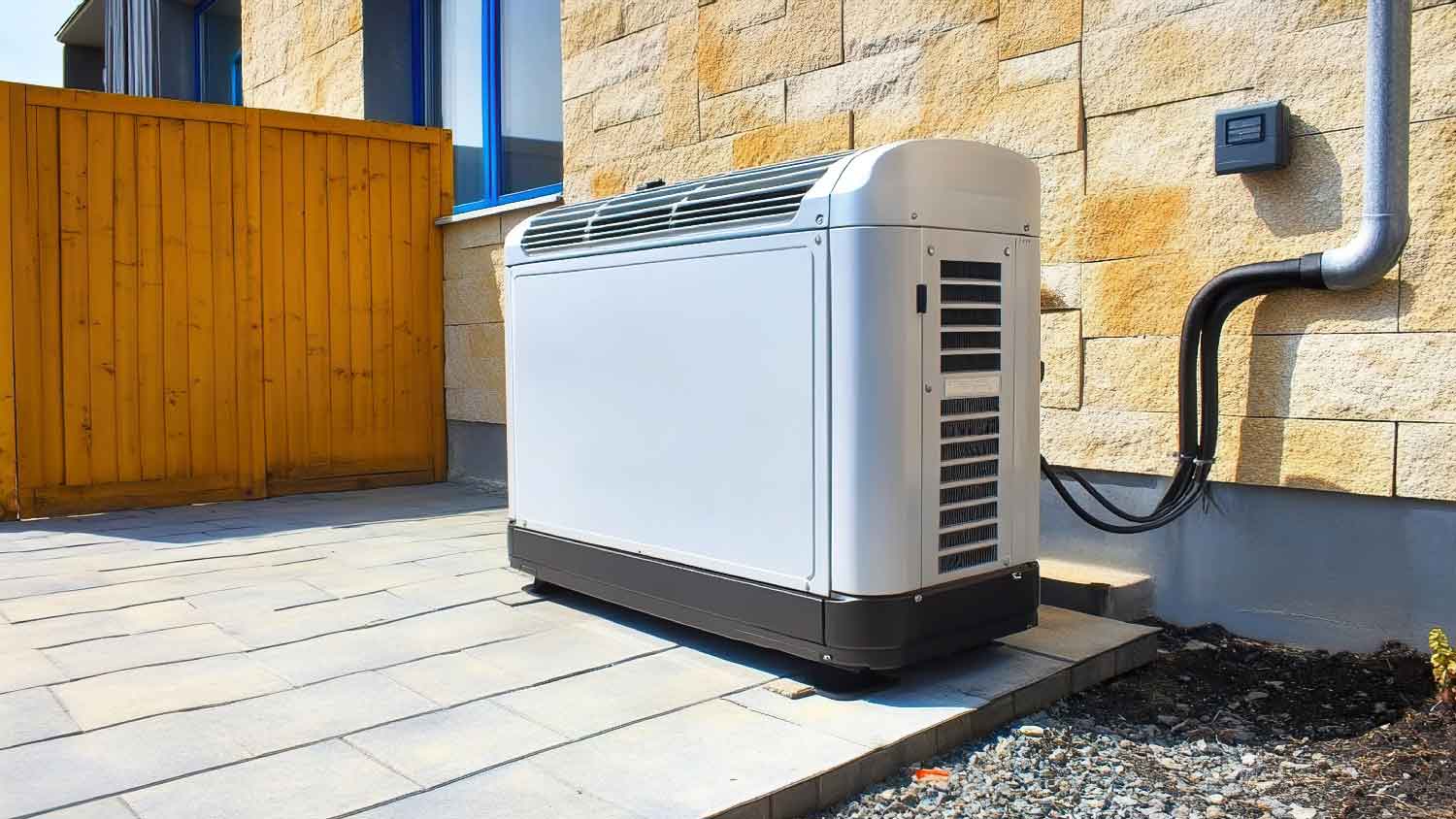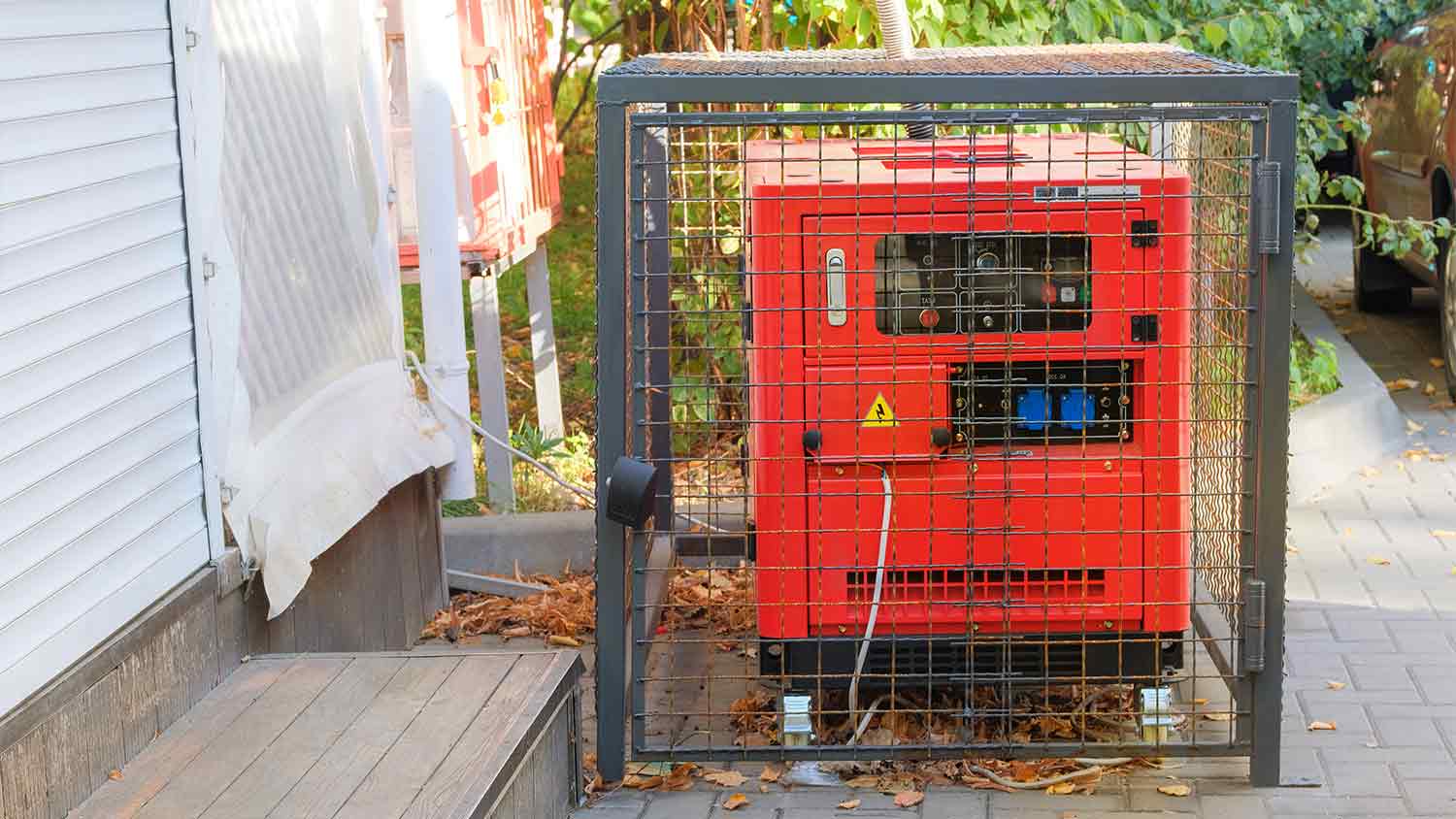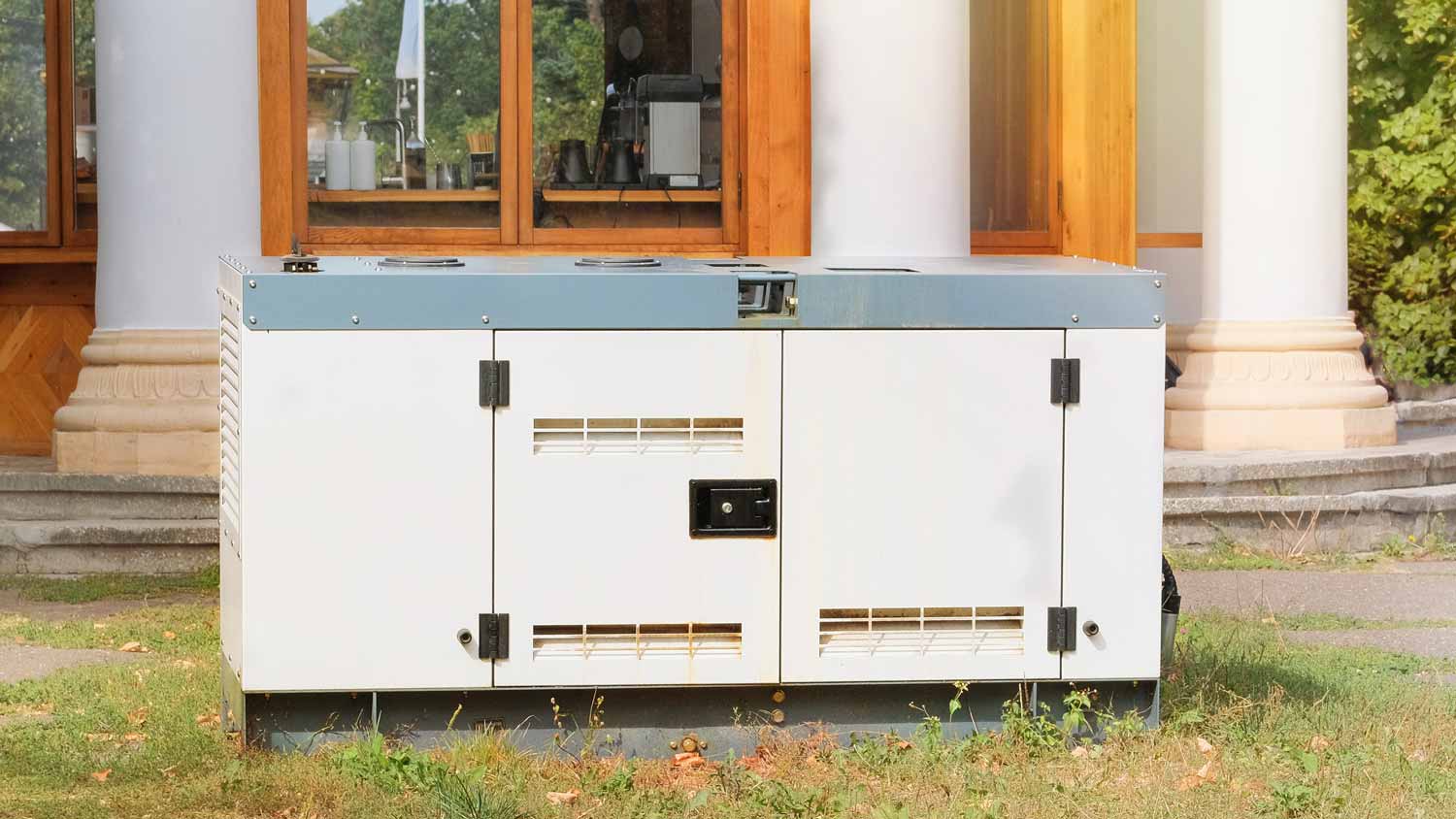Whole-House Generator Installation: A Complete Guide
No power? No problem.


Whole home generators power your home during outages.
The right generator capacity is key to choosing the right system.
Natural gas and propane are the most common fuel types.
You might need an electrical and plumbing permit.
When a power outage strikes, worrying about critical medical devices, the food in your freezer, or the temperature in your house can make anyone panic. However, whole-house generator installation can help you avert a crisis by providing reliable back-up power. Here’s everything you need to know before you install this type of home generator.
For a worry-free power backup, leave generator fixes and installations to generator professionals who have the skills, tools, and knowledge required to handle these complex systems.
What Is a Whole-House Generator?

A whole-house generator, also called a standby generator, is a standby power system that turns on and powers your home when the power goes out. It is permanently installed and connected to your electrical system and a fuel source (more on that later). When your home’s primary power goes out, say due to a bad storm, the generator can detect the outage and turn on thanks to it’s fuel supply, giving power to your home.
Depending on the size generator you choose, you might be able to power on a few critical things like medical equipment, a refrigerator, or lighting. Or, if you choose to install a large whole-house generator, you can power all home appliances and systems, including multiple air conditioners. A generator installer near you can discuss the different sizes available to determine what would best work for your home.
Why You Need a Whole-House Generator
If you live in a climate that experiences extreme temperatures or potentially devastating weather events, a whole-house generator might be a great benefit. Investing in a whole-home generator can benefit you in the following ways:
Helps prevent bursting pipes
Keeps the fridge and freezer on and prevents food from spoiling
Provides power for essential medical equipment
May increase your home’s value
Runs longer than a portable generator
Offers added security and peace of mind
Speak with a local generator installer if you’re unsure that your home could benefit from this addition. They can assess whether you should consider one based on your region and advise on what size would work with your appliances.
Choosing the Right Whole Home Generator Fuel

The type of fuel you choose for your whole home generator largely influences the cost of running your generator. Some generators can run on natural gas, gasoline, or propane interchangeably, so be sure to check the manual for specifications. Your unit will use one of the following fuel types.
Important note: Fuel costs vary by location, time, home size, and number of home appliances. We’re basing costs on a generator large enough to the average home, running at full load.
| Fuel Type | Features | Cost |
|---|---|---|
| Natural Gas | Affordable, requires infrastructure, no refills needed | $1–$3 per hour |
| Propane | More expensive, no infrastructure needed, requires refills | $10 per hour |
| Diesel | Easy maintenance, may be harder to find a supply | $5–$7 per hour |
| Gasoline | Widely available, difficult maintenance, rarely used in whole-home generators | $12 per hour |
Natural Gas
Natural gas is an affordable fuel for generators. While it carries less energy than the other options, natural gas is so widely available that you don’t have to worry about running out. Most local utility companies will deliver the natural gas through pipelines to your home. Keep in mind that this option might not be the best choice if you live in a rural area that doesn’t have a pipeline for natural gas.
Liquid Propane
Propane is the most environmentally-friendly fuel and comes in a close second to natural gas. This clean-burning and renewable fuel comes in tanks and has an indefinite shelf life. If you don’t have a tank large enough for storing propane, be prepared to store multiple tanks.
Diesel
The most energy-packed fuel is diesel. This option is easy to maintain since you don’t need spark plugs. To save money on the cost of powering your generator, consider using a local fuel delivery company to deliver and pump diesel directly into your fuel tank.
Gasoline
The most available type of fuel for generators is gasoline; however, you’ll find that gasoline-powered generators rarely come in whole home generators and are almost exclusively made for portable generators.
Portable vs. Standby Generator
When shopping for generators, you will see options for portable generators you can wheel into place, and standby generators with a permanent location. In this case, there’s no competition. Portable generators are too small and unwieldy to be whole-house generators. They are more useful to power up a few vital appliances in a shop. Whole-house generators are standby models positioned permanently outside, often with the ability to switch on during blackouts.
How Much Does Whole-House Generator Installation Cost?
The cost to install a whole-house generator is between $1,600 and $8,900 for most homeowners. Depending on the size of generator you need, you could expect to spend up to $21,000 or more, though smaller generators that can power your refrigerator, freezer, sump pump, and lighting will be significantly less expensive. Speak to your local generator installer to determine the best size whole-house generator based on your needs, and they’ll be able to give you an accurate estimate.
| Generator Size | Average Cost Range, Materials Only | What It Can Power |
|---|---|---|
| 1–6kW | $500–$1,800 | Refrigerator, freezer, sump pump, lighting, and a few small appliances |
| 7.5–10kW | $2,000–$3,500 | All essential appliances plus a well pump, furnace fan, and additional lighting and outlets |
| 14–18kW | $4,000–$5,500 | All essential appliances plus air conditioning, hot water heater, and additional appliances |
| 20–24kW | $5,000–$6,500 | All essential and non-essential appliances, including multiple air conditioners and electric ranges |
| 26–32kW | $6,500–$15,000 | All home appliances and systems, including larger HVAC systems and multiple hot water heaters |
| 36–38kW | $14,000–$16,000 | All home appliances and systems, including commercial-grade equipment |
| 45–48kW | $16,200–$21,000 | All home appliances and systems, including multiple air conditioners, electric ranges, and commercial-grade equipment |
Where Will Your Generator Be Installed?
Installation is the most important (and time-consuming) part of adding a whole-house generator.
Selecting a Location
Building codes and safety factors will limit where you can place a generator. Before you purchase a model, choose a location carefully using these guidelines:
Must be 4 feet away from exterior walls
Must be 3 feet away from any flammable materials
Avoid installing near decks or bushes
Install generators away from windows and vents
Install the generator as close to your current electrical meter (and gas line, if using natural gas) as possible
Location Prep
Generators, especially large whole-house models, need a level surface and must be placed above the ground away from dirt.
Preparation includes leveling the surface, often with a compacted soil or gravel substrate, and installing a pad or pedestal. This step usually includes either a pre-cast concrete base (heavy to transport) or pouring your own cement base (time-consuming). You can hire contractor pros to complete this step if needed.
Installation
Once you have the generator and required switches and connections, installation should only take a few hours. But preparing the location can take a few days of work, so plan accordingly when setting up your generator. It’s best to plan the installation for a warm, dry period where rain won’t interrupt your work or the concrete installation.
Questions to Ask Your Pro
As you collect estimates and quotes, here are a few things to ask your local generator installer:
1. What’s the Best Fuel Source for My Situation?
Local generator pros will be familiar with fuel costs in your area, the availability of natural gas vs. propane, and other key details. Before you choose a system, ask their advice about the best fuel to use and the expected costs. Ask them what types of generators other people in the area use and how they seem to work.
2. Are There Any Additional System Requirements?
Whole-house generators are more complex than plug-in models, and often require electrical changes. That could include updating your circuit breakers or installing new wiring to reach your generator’s location. Always discuss this additional electrical work with your generator installer and get an estimated cost.
3. What Connections Are Best for My Generator?
When connecting a whole-house generator to your home’s wiring, it requires a transfer switch to safely transition power sources without overloading the electrical system. Transfer switches come in various types and amp ratings—manual switches allow on-demand switching to generator power, while automatic switches activate during blackouts. They offer customization options, such as powering specific rooms or outbuildings selectively. Discuss your power needs, blackout priorities, and the ideal transfer switch with your electrician to ensure the best setup for your home.
4. Are There Any Property Restrictions I Should Know About?
Generator use and installation rules vary based on your city and state. Before you settle on a final location for your whole-home generator, ask an experienced electrician about local codes to ensure you adhere to them.
5. Do I Need a Permit for a Whole-House Generator?
Because of the home electrical work involved, you may need to purchase a permit for the work or have your electrician handle it. Permits can add $50 to $100 to your bill, so we suggest talking about any permits beforehand to avoid surprises.
Consider Hiring a Pro to Install Your Generator
Installing a whole house generator requires extensive electrical knowledge and skills, as well as assembly, placement, permits, and more. This is not a DIY project. Instead, hire a local home generator installer to install your new generator system safely. Generator pros will ensure your whole-house generator is placed correctly and safely, preparing you for the next power outage with ease.
How to Prepare for Your Generator Installation
If you’ve booked a generator installation with a professional, the final steps are to make preparations for this new appliance in your home. Consider taking these prep steps to make the generator installation go smoothly:
Choose the placement: Determine the installation spot, which must be an open, safe outdoor space close to the electric and gas meters.
Choose the fuel source: You should know the type of fuel your generator will require, choosing from options like gas, propane, diesel, or natural gas.
Consider property restrictions: Consider property-specific features that may affect your generator installation, such as underground wiring or difficult terrain, and tell your generator pro about them before the appointment.
Frequently Asked Questions
A whole house generator can be worth the extra money for peace of mind if your home is prone to power outages for extended periods of time or if you have life-saving medical equipment that needs to maintain power at all times. These devices can also increase your home’s value, especially in areas prone to extreme weather and power outages.
A home that is 2,500 square feet will likely need a 20kW to 25kW generator. Consult your local generator installer to confirm the generator size needed to power your home before purchasing a new one. Be sure to consider how much power your necessary devices need to run.
A 1,500 square foot home will likely need a 15kW to 20kW generator. When deciding on whole-house generator size, add up the total wattage of the devices that you’d like to continue running during a power outage. That way, you can ensure you purchase a generator that can power your necessary appliances or medical equipment during an electrical emergency.





- Who Installs Generators? A Complete Guide
- Who Can I Hire to Fix a Generator?
- 8 Types of Generators for Homeowners
- Can a Generator Get Wet? What You Need to Know
- 15 Generator Uses for Homeowners
- A Complete Generator Maintenance Checklist
- What Size Generator Do I Need? A Guide to Choosing the Right Generator for Your Home
- Whole-House Generator Sizing: Everything You Need to Know
- Do Pellet Stoves Need Electricity and Can You Operate Them During a Power Outage?
- 10 Things to Do When the Power Goes Out at Home
















